Based on materials from www.theverge.com
Deja vu (fr. Déjà vu – 'already seen') is a mental state in which a person feels that he has once been in a similar situation.
Before us HTC One M9 is a new flagship from the once powerful smartphone manufacturer, a follower of last year's M8. A device that is exceptionally similar to its predecessor: almost all aluminum, 5-inch 1080p screen, really loud speakers above and below it, as well as unmatched in the world Android build and design quality.
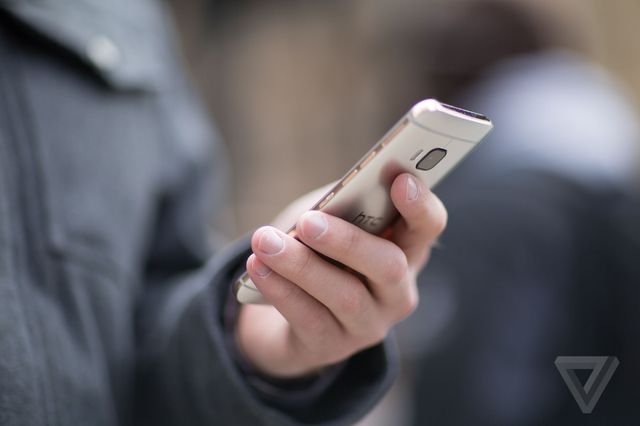
The M8 was a gorgeous device – beautiful, fast, with good software, great sound and a crisp screen. All this is inherent in the M9, as well as it is intended to correct two shortcomings of the M8, which strove to slip out of the hand and took mediocre pictures. Of course, of these shortcomings, the second is more important: it was the camera that did not allow calling this smartphone really good.
And yet, the feeling of déjà vu has not been shed, despite all the improvements.
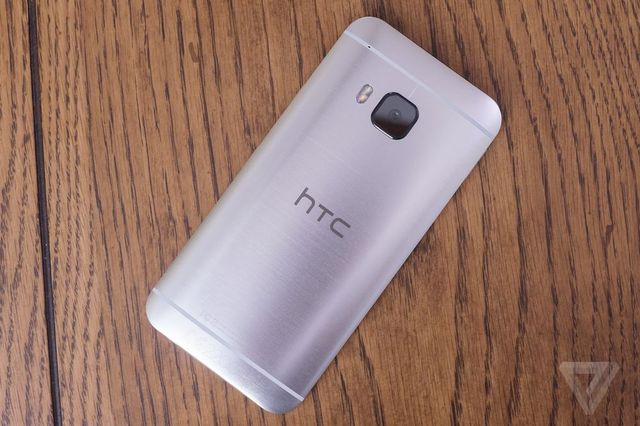
Déjà vu can create a wide variety of sensations: pleasant, intimidating, or even surreal. In the case of the M9, there is a little bit of everything. And it makes sense to start with the good, because there is something, but there is a lot of good here. The M9 has a chic design, a pleasant texture, it feels great in the hand and is unlike any existing smartphone. Except for the M8, of course. And keeping in mind that the M8 looked great too, that's not bad at all.
The main visual difference is the sharper edges in the M9 and the power button, which has moved from the top edge, as in the M8, to its side. HTC say their goal was to combine the best of the M7 from two years ago and last year's M8. And I must say, it succeeded. You most likely saw the M9 in a two-tone version – silver with gold ends. For those who are not a fan of such combinations, other options look prettier (completely black, gold or even pink). The texture is more radiant than the matte one that was last year, it also allows you to better hold the device in your hand.

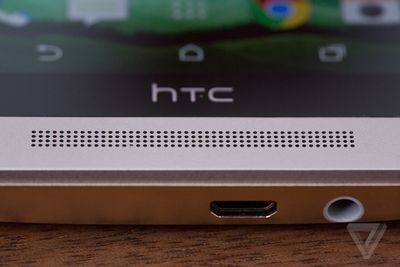
The M9's relocated power button is easier to use, but it can also be easily confused by touch with the higher volume buttons. They could be spaced along different edges, but that's not such a big problem.
In general, the tactile experience of using the M9 is similar to the M8 – the device lies in the hand, is used, taken out of clothes and removed in much the same way, except that there is less fear of dropping it at any moment, like a wet bar of soap. The M9 is slightly shorter and quite a bit thicker than its predecessor, but the difference is not noticeable in everyday use.
It's the same with the 5-inch 1080p screen and front-facing speakers. The screen is distinguished by correct color rendition and brightness sufficient for outdoor use. In terms of the number of pixels, the screen does not match other smartphones, but the density is such that you will not see individual pixels or irregularities with the naked eye. The front-facing Boom Sound stereo speakers still sound great and are even slightly louder on the M9.

The M9 is also very nimble. Inside, it has a flagship processor from Qualcomm Snapdragon 810 and 3GB of RAM, which means you don't have to wait for an app to open or the home screen to be drawn. That doesn't mean the M8 was slow – it wasn't in any way, but the M9 showed a new level of speed. This is almost the fastest Android smartphone. Speed goes hand in hand with energy efficiency: the M9 has a slightly larger battery than the M8 and easily lasts all day on a single charge. More than a day away from the outlet, like the larger phablets with their larger batteries, it won't survive, but if you charge your devices every night anyway, it won't be a problem.
The speed of the phone is partly due to the new version of Sense, its own add-on HTC over Android 5.0. It's responsive and fast, and unlike other custom skins, it doesn't slow you down. Visually, it is very similar to the software in the M8 and has all the same features. It is only necessary to highlight two new important features. It's a new theme generator that lets you quickly customize how your phone looks and sounds, and a home screen widget that predicts what apps you need based on your location.
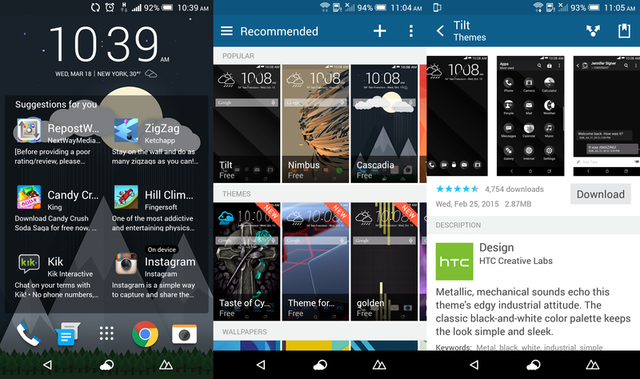
The ability to change themes is great, it's a pleasure to play around with. You can quickly change wallpapers, app icons, fonts, sounds and more on your M9 by downloading a selection of themes. Or you can create your own on the site HTC, download it to your phone or share with other users. You can even create a custom theme to match your photo's color scheme. In general, the ability to create themes exceeds expectations and expands the possibilities of customization Android in such a pleasant way.
The predictive widget is less impressive. It serves to select the right apps for home, work or travel based on your location. Well, let's say, when I'm in the office, mail services and a calendar come first, and when I'm on the road – maps and music. In theory, the idea is useful, although not new (there are third-party launchers that offer this functionality), but the version from HTC needs some work. It remembers the owner's habits for too long, clogs the widget with applications that are ridiculously out of place, and some are already installed on the device. Fortunately, this is just a widget – demolished and forgotten.
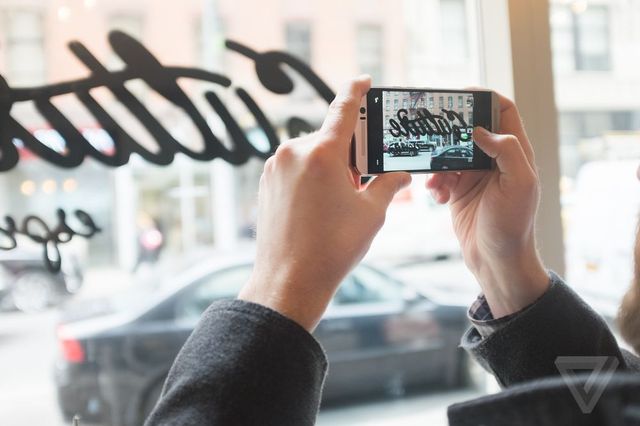
However, while the M8 had a number of critical flaws, not everything is perfect with the M9. The main problem with the M8 was its camera, with its low resolution and 'ultrapixels', it couldn't compete with the best solutions from Apple and Samsung. It was equipped with a second sensor to play with depth of field, but it felt more like a gimmick than something useful.
In М9 HTC a completely different approach was taken. The main camera has a high resolution, 20 MP sensor, and the second sensor is missing. The 'ultra-pixel' camera has moved to the front, where it does the job of taking selfies in low light, and lack of pixels is not an issue here. And the new main camera has an abundance of pixels – this is the company's response to criticism of the M8 for not high resolution.
Unfortunately, this approach did not provide outstanding results, and often the photos from the M9 are even worse than they were last year. The number of pixels that the M8 lacked, the M9 has, but the pictures often show the noise reduction, and the details look blurry. In conditions of insufficient light, the color gamut sometimes turns out to be strange, unpleasantly overexposed areas are observed in the light. In good lighting conditions, the camera has problems transmitting a wide range of illumination from light to dark.
The current camera software, the app that takes the pictures, is great – it's fast, easy to use, and gives you quick access to settings like white balance if you need them. But in any case, the end result is not as good as one would expect from the 2015 flagship.
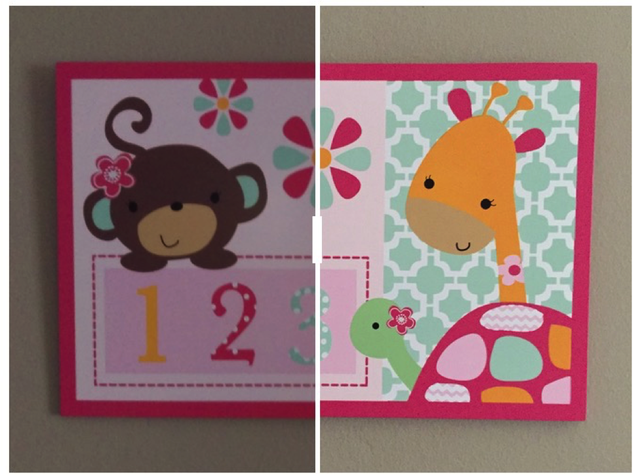
left – photo HTC One M9, right – iPhone 6 (images cropped, resized for network)
When we 'bump' the M9 and the iPhone 6 face to face in different situations, we see that the first comes out softer, the exposure is lame, noise reduction artifacts are visible, giving the photo a 'water color', and white balance is not always accurate. In almost any case, the iPhone shot better. Apple (and of course Samsung) has a huge advantage: they control the production of components and can choose the best for their cameras before everyone else. HTC does not have such an opportunity, and in the case of the M9 it is clearly visible.
The only thing that needed to be changed HTC was the camera. The design has not changed, there is nothing new in the screen, the software is practically the same. And so, focusing all the attention on the camera, HTC again failed.

The literal translation of déjà vu from French sounds like 'already seen'. In the case of the M9, most of the good and the bad, we've actually seen.
On the plus side, the M9 is a smart phone with great design, great screen and sound, fast, and a battery that lasts all day. Everything is the same as last year. On the downside, the M9's camera is a big disappointment. Not only because it hasn’t improved over the M8, but also because it doesn’t work as well as competing solutions.
Speaking of competitors, HTC did nothing to solidify their position in the premium segment, where competition is insanely high. The closest adversary, Samsung, has convincingly bridged the hardware and design divide with its Galaxy S6. And, of course, his superiority in terms of the camera is overwhelming. And iPhone has long been a well-designed phone that can take better 'point and shoot' shots than most smartphones on the market.
Nowadays, a smartphone is not just a phone. This is the only camera that the user often owns, and this trend is only growing. It so happens that a smartphone is bought based only on how it shoots. And so the camera can sell the phone, or it can kill. Unfortunately, the M9 (and before it the M8) is the second case.
For the third year in a row HTC it has created one of the most attractive outwardly devices that are as pleasant to hold as to look at. And for the third year in a row, makes unforgivable mistakes that negate the entire great user experience.
So here's another definition for you. “Madness is doing the same thing over and over again and expecting different results.”
